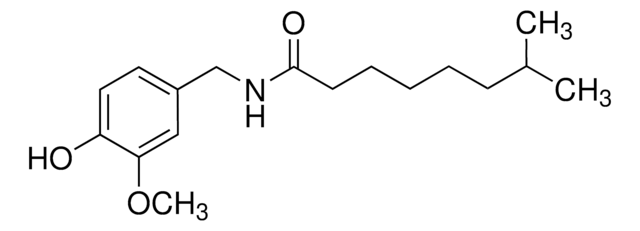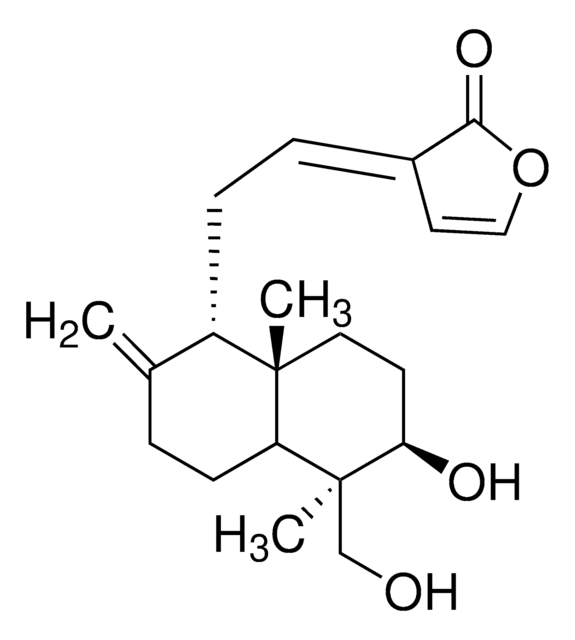03813
Dihydrocapsaicin
analytical standard
Synonyme(s) :
6,7-Dihydrocapsaicin, 8-Methyl-N-vanillylnonanamide, N-[(4-Hydroxy-3-methoxyphenyl)methyl]-8-methylnonenamide
About This Item
Produits recommandés
Qualité
analytical standard
Niveau de qualité
Pureté
≥97.0% (HPLC)
Durée de conservation
limited shelf life, expiry date on the label
Technique(s)
HPLC: suitable
gas chromatography (GC): suitable
Application(s)
cleaning products
cosmetics
flavors and fragrances
food and beverages
personal care
Format
neat
Température de stockage
2-8°C
Chaîne SMILES
COc1cc(CNC(=O)CCCCCCC(C)C)ccc1O
InChI
1S/C18H29NO3/c1-14(2)8-6-4-5-7-9-18(21)19-13-15-10-11-16(20)17(12-15)22-3/h10-12,14,20H,4-9,13H2,1-3H3,(H,19,21)
Clé InChI
XJQPQKLURWNAAH-UHFFFAOYSA-N
Vous recherchez des produits similaires ? Visite Guide de comparaison des produits
Description générale
Application
It may be used as a reference standard for the determination of dihydrocapsaicin in Capsicum fruit samples by HPLC equipped with a Surveyor photodiode array (PDA) detector and in rat plasma by HPLC-triple quadrupole MS with electrospray ionization (ESI) in selected reaction monitoring (SRM) mode.
Actions biochimiques/physiologiques
Liaison
Mention d'avertissement
Danger
Mentions de danger
Conseils de prudence
Classification des risques
Acute Tox. 2 Oral - Eye Irrit. 2 - Skin Irrit. 2 - STOT SE 3
Organes cibles
Respiratory system
Code de la classe de stockage
6.1A - Combustible acute toxic Cat. 1 and 2 / very toxic hazardous materials
Classe de danger pour l'eau (WGK)
WGK 3
Point d'éclair (°F)
Not applicable
Point d'éclair (°C)
Not applicable
Choose from one of the most recent versions:
Déjà en possession de ce produit ?
Retrouvez la documentation relative aux produits que vous avez récemment achetés dans la Bibliothèque de documents.
Les clients ont également consulté
Notre équipe de scientifiques dispose d'une expérience dans tous les secteurs de la recherche, notamment en sciences de la vie, science des matériaux, synthèse chimique, chromatographie, analyse et dans de nombreux autres domaines..
Contacter notre Service technique







